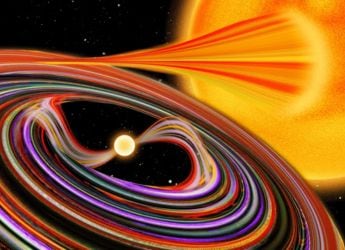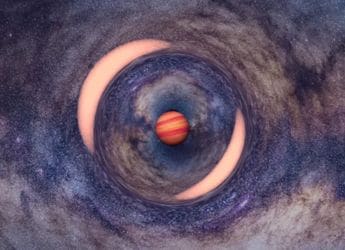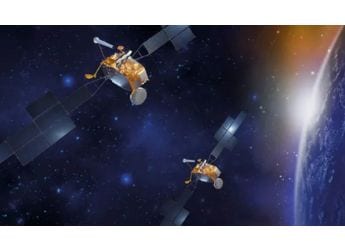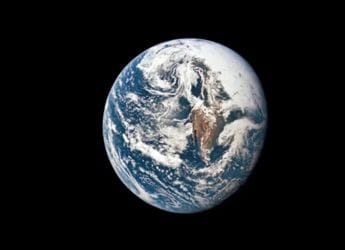- Home
- Science
- Science News
- Sun's Surface Seen in Remarkable New Detail in Fresh Images From Solar Telescope
Sun's Surface Seen in Remarkable New Detail in Fresh Images From Solar Telescope
The Daniel K Inouye Solar Telescope (DKIST) in Hawaii has released pictures that show features as small as 30km across the sun.

Photo Credit: NSO/ AURA/ NSF
The Sun has a diameter of 1.4 million kilometres and is 149 million kilometres from Earth
Never-before-seen images of the Sun's turbulent surface have been released by astronomers in the US. The Daniel K Inouye Solar Telescope (DKIST) in Hawaii has released pictures that show features as small as 30km across the sun, reported the BBC.
This is remarkable when set against the scale of our star, which has a diameter of about 1.4 million kilometres and is 149 million kilometres from Earth. The cell-like structures are roughly the size of the US state of Texas. They are convecting masses of hot, excited gas, or plasma.
The bright centres are where this solar material is rising; the surrounding dark lanes are where plasma is cooling and sinking. The DKIST is a brand new facility positioned atop Haleakala, a 3,000 metres tall volcano on the Hawaiian island of Maui.
Its 4-metre primary mirror is the world's largest for a solar telescope. The telescope will be used to study the Sun's workings. Scientists want fresh insights on its dynamic behaviour in the hope that they can forecast better its energetic outbursts - - what is often referred to as "space weather".
Colossal emissions of charged particles and entrained magnetic fields have been known to damage satellites at the Earth, to harm astronauts, degrade radio communications, and even to knock power grids offline.
DKIST is a complement to the Solar Orbiter (SolO) space observatory which is being launched next week from Cape Canaveral in Florida. This joint European-US probe will take pictures of the Sun from the closest ever vantage point from just 42 million kilometres from the surface.
Catch the latest from the Consumer Electronics Show on Gadgets 360, at our CES 2026 hub.
Related Stories
- Samsung Galaxy Unpacked 2025
- ChatGPT
- Redmi Note 14 Pro+
- iPhone 16
- Apple Vision Pro
- Oneplus 12
- OnePlus Nord CE 3 Lite 5G
- iPhone 13
- Xiaomi 14 Pro
- Oppo Find N3
- Tecno Spark Go (2023)
- Realme V30
- Best Phones Under 25000
- Samsung Galaxy S24 Series
- Cryptocurrency
- iQoo 12
- Samsung Galaxy S24 Ultra
- Giottus
- Samsung Galaxy Z Flip 5
- Apple 'Scary Fast'
- Housefull 5
- GoPro Hero 12 Black Review
- Invincible Season 2
- JioGlass
- HD Ready TV
- Laptop Under 50000
- Smartwatch Under 10000
- Latest Mobile Phones
- Compare Phones
- Motorola Signature
- Vivo Y50e 5G
- Vivo Y50s 5G
- Realme 16 Pro+ 5G
- Realme 16 Pro 5G
- TCL Nxtpaper 70 Pro
- OPPO A6 Pro 5G
- Honor Power 2
- Lenovo Yoga Slim 7x (2025)
- Lenovo Yoga Slim 7a
- Realme Pad 3
- OPPO Pad Air 5
- Xiaomi Watch 5
- Huawei Watch 10th Anniversary Edition
- Acerpure Nitro Z Series 100-inch QLED TV
- Samsung 43 Inch LED Ultra HD (4K) Smart TV (UA43UE81AFULXL)
- Asus ROG Ally
- Nintendo Switch Lite
- Haier 1.6 Ton 5 Star Inverter Split AC (HSU19G-MZAID5BN-INV)
- Haier 1.6 Ton 5 Star Inverter Split AC (HSU19G-MZAIM5BN-INV)
-
 NASA’s IXPE Creates History: Becomes First to Measure a White Dwarf Star
NASA’s IXPE Creates History: Becomes First to Measure a White Dwarf Star
-
 Astronomers Detect Rare Rogue Planet Drifting Alone 10,000 Light-Years from Earth
Astronomers Detect Rare Rogue Planet Drifting Alone 10,000 Light-Years from Earth
-
 Space Particle Collision Raises Uncertainty Over Spain’s New Military Satellite
Space Particle Collision Raises Uncertainty Over Spain’s New Military Satellite
-
 New Experiments Suggest RNA Could Have Formed Naturally, Supporting ‘RNA World’ Origin of Life Theory
New Experiments Suggest RNA Could Have Formed Naturally, Supporting ‘RNA World’ Origin of Life Theory










